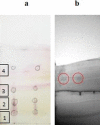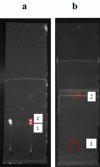Evaluation of the chemical defense fluids of Macrotermes carbonarius and Globitermes sulphureus as possible household repellents and insecticides
- PMID: 33420232
- PMCID: PMC7794475
- DOI: 10.1038/s41598-020-80018-5
Evaluation of the chemical defense fluids of Macrotermes carbonarius and Globitermes sulphureus as possible household repellents and insecticides
Abstract
The use of chemical insecticides has had many adverse effects. This study reports a novel perspective on the application of insect-based compounds to repel and eradicate other insects in a controlled environment. In this work, defense fluid was shown to be a repellent and insecticide against termites and cockroaches and was analyzed using gas chromatography-mass spectrometry (GC-MS). Globitermes sulphureus extract at 20 mg/ml showed the highest repellency for seven days against Macrotermes gilvus and for thirty days against Periplaneta americana. In terms of toxicity, G. sulphureus extract had a low LC50 compared to M. carbonarius extract against M. gilvus. Gas chromatography-mass spectrometry analysis of the M. carbonarius extract indicated the presence of six insecticidal and two repellent compounds in the extract, whereas the G. sulphureus extract contained five insecticidal and three repellent compounds. The most obvious finding was that G. sulphureus defense fluid had higher potential as a natural repellent and termiticide than the M. carbonarius extract. Both defense fluids can play a role as alternatives in the search for new, sustainable, natural repellents and termiticides. Our results demonstrate the potential use of termite defense fluid for pest management, providing repellent and insecticidal activities comparable to those of other green repellent and termiticidal commercial products.
Conflict of interest statement
The authors declare no competing interests.
Figures


Similar articles
-
Insecticidal and repellent efficacy against stored-product insects of oxygenated monoterpenes and 2-dodecanone of the essential oil from Zanthoxylum planispinum var. dintanensis.Environ Sci Pollut Res Int. 2019 Aug;26(24):24988-24997. doi: 10.1007/s11356-019-05765-z. Epub 2019 Jun 26. Environ Sci Pollut Res Int. 2019. PMID: 31240663
-
Insecticidal Activities and Chemical Composition of the Essential Oils of Ajania nitida and Ajania nematoloba from China.J Oleo Sci. 2018 Dec 1;67(12):1571-1577. doi: 10.5650/jos.ess18102. Epub 2018 Nov 15. J Oleo Sci. 2018. PMID: 30429442
-
Phytochemical profile and insecticidal activity of Agave americana leaf extract towards Sitophilus oryzae (L.) (Coleoptera: Curculionidae).Environ Sci Pollut Res Int. 2019 Jul;26(19):19468-19480. doi: 10.1007/s11356-019-05316-6. Epub 2019 May 10. Environ Sci Pollut Res Int. 2019. PMID: 31077051
-
[Study on essential oils of medicinal plants in insect repellent].Zhongguo Zhong Yao Za Zhi. 2016 Jan;41(1):28-34. doi: 10.4268/cjcmm20160106. Zhongguo Zhong Yao Za Zhi. 2016. PMID: 28845635 Review. Chinese.
-
Chemical and Plant-Based Insect Repellents: Efficacy, Safety, and Toxicity.Wilderness Environ Med. 2016 Mar;27(1):153-63. doi: 10.1016/j.wem.2015.11.007. Epub 2016 Jan 27. Wilderness Environ Med. 2016. PMID: 26827259 Review.
Cited by
-
Comparative genomics unravels a rich set of biosynthetic gene clusters with distinct evolutionary trajectories across fungal species (Termitomyces) farmed by termites.Commun Biol. 2024 Oct 5;7(1):1269. doi: 10.1038/s42003-024-06887-y. Commun Biol. 2024. PMID: 39369058 Free PMC article.
References
-
- Batalha LS, Silva Filho DF, Martius C. Using termite nests as a source of organic matter in agrosilvicultural production systems in Amazonia. Scientia Agricola. 1995;52:318–325. doi: 10.1590/S0103-90161995000200019. - DOI
-
- Ayuke FO, et al. Soil fertility management: Impacts on soil macrofauna, soil aggregation and soil organic matter allocation. Appl. Soil. Ecol. 2011;48:53–62. doi: 10.1016/j.apsoil.2011.02.001. - DOI
-
- Jouquet P, Chaudhary E, Kumar ARV. Sustainable use of termite activity in agro-ecosystems with reference to earthworms A review. Agron. Sustain. Dev. 2018;38:3. doi: 10.1007/s13593-017-0483-1. - DOI
-
- Deligne J, Quennedey A, Blum MS. The enemies and defense mechanisms of termites. In: Hermann HR, editor. Social Insects. Cambridge: Academic Press; 1981. pp. 1–76.
-
- Grasse PP. Termitologia, Tome III. Paris: Masson; 1986.
Publication types
MeSH terms
Substances
LinkOut - more resources
Full Text Sources
Other Literature Sources
Miscellaneous

